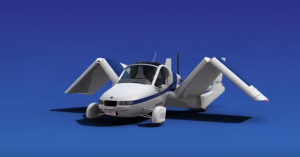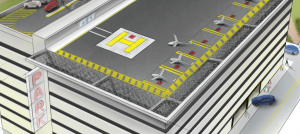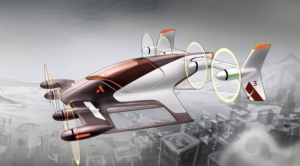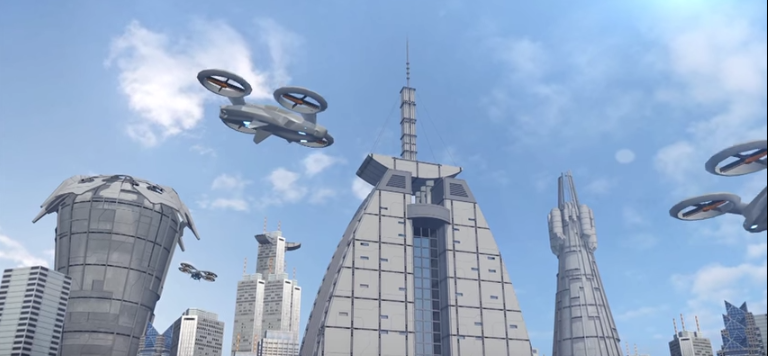aNewDomain — Is the world ready for flying taxis on demand? Looks that way. Uber today released a 98-page paper (embedded below) and some initial ideas on how to bring about just that. Its proposed system, dubbed Uber Elevate, would make flying car travel just a call away.

But is the tech there? We took a closer look at Uber’s plans and, specifically, at some of the flying car makers it mentioned in its paper today. Those include futuristic concepts from such firms as A3/Airbus and Joby Aviation, the Larry Page backed startup Zee.Aero, China’s Ehang and a German effort with a wild, egg-shaped vertical take off and landing jet called Lilium.
Scroll below to check them out in detail — and scroll all the way to the bottom to read Uber’s futuristic flying car-based air taxi vision report in full.
What’s new here
 In a blog post titled Fast Forwarding to a Future of On-Demand Urban Air Transportation, Uber product chief Jeff Holden today outlined some of the top line ideas behind its so-called Uber Elevate vision.
In a blog post titled Fast Forwarding to a Future of On-Demand Urban Air Transportation, Uber product chief Jeff Holden today outlined some of the top line ideas behind its so-called Uber Elevate vision.
Essentially it’s an air-taxi hailing system that will enable commuters to access electric, helicopter-like Vertical Take-Off and Landing (VTOL) vehicles in the same manner they can now call for Uber, taxis and other rides.
Such vehicles would take off from and land on “vertiports,” that is, helipads located on roofs or even alongside roadsides, he said.
Uber execs say they don’t plan on building such futuristic flying cars, but rather are focused on jump starting the flying car industry and policies necessary to make the futuristic air taxi service they describe possible.
So who will build these things? In its 98-page feasibility and concept paper, which you’ll find beneath the videos and explanations below , Uber specifically mentions six flying car efforts now underway in the US, Europe and Asia. These are the sorts of vehicles Uber says it has in mind, while listing pros and cons of the various approaches.
Here’s a rundown.
The Players
Joby Aviation is one of the flying car makers Uber mentioned in the paper.
Its S2 and S4 vehicles feature a distributed set of tilting prop-rotors that “rotate with the direction of flight so that the propulsors provide both vertical lift and thrust throughout the flight,” according to the paper. Check out the Joby S2 concept video below.
Airbus’ CityAirbus
Earlier this month, A3, the Silicon Valley arm of Airbus unveiled its Vahana 18 concept vehicle for the first time last August, a project Uber also specifically mentions in its paper. Rather than articulating the prop-rotors, this concept vehicle, dubbed CityAirbus, is a multi-passenger vehicle that utilizes a tiltwing/tilt-tail approach, “similar to the recent NASA GL-10 DEP flight demonstrator19,” the paper’s authors point out. It’s a simpler approach that requires just two actuators, they add.
 According to Airbus Group’s magazine, a VTOL prototype that uses electric propulsion and multiple ducted propellers, will eventually be fully autonomous. It will be tested in the air by the end of next year, execs said.
According to Airbus Group’s magazine, a VTOL prototype that uses electric propulsion and multiple ducted propellers, will eventually be fully autonomous. It will be tested in the air by the end of next year, execs said.
That’s an image of the concept vehicle provided to journalists early this week, above left.
eVolo’s Volocopter VC200
Filed under “other approaches,” in the paper are two efforts: the eVolo Volocopter 200 (VC200) and the Chinese-designed eHang 184 quad/octocopter.
Such “multi-copter approaches will be significantly slower (under 60 mph) with shorter range capability, as well as lower efficiency since they aren’t using wing-borne flight,” points out the authors of the Uber research paper, without setting them aside completely.
Watch them both in action, below.
Ehang 184
EHang 184, from China-based Ehang, is billed by its makers as “the world’s first electric, personal Autonomous Aerial Vehicle (AAV)” capable of achieving “humanity’s long-standing dream of easy, everyday flight for short-to-medium distances.”
Here’s the publicity video Ehang published quietly on YouTube eight months ago. Check it out.
And from Germany: Lilium
The authors of the Uber paper point out that the high-profile German concept, the Lilium, is a “push to extremely high levels of distribution while coupling the vertical lift in closely with the wing high-lift system.” The concern here, however, is that such jet-lift approaches “will require substantially higher power for takeoff and landing, with greater challenges operating quietly within cities,” according to the Uber paper.
From the looks of it, Lilium still looks awfully cool. Due in 2018, Lilium is an egg-shaped plane and oft noted as a key development by European Space Agency (ESA) reps. Capable of a top speed of 250mph and a range of 300 miles, it is said to require just a 50×50 foot place to take off. Here are some more details, below.
Zee.Aero
Zee Aero and Kitty Hawk are two flying car manufacturers said to be backed by Google cofounder Larry Page. The former is mentioned by name in the Uber paper in its discussion on what it considers to be “the four primary barriers to commercial feasibility” of an airtaxi service: safety, noise, emissions, and vehicle performance.
“The two most important technologies to overcome these challenges are Distributed Electric Propulsion (DEP) and autonomous operation technologies. Several manufacturers have demonstrated concepts which showcase ways to use DEP technology in order to achieve different advantages (and penalties), depending whether the designer favors cruise efficiency, hover power required, vehicle control, design simplicity, payload, or vehicle cost. Zee.Aero is the largest of these companies with a focus on advancing the required component technologies (i.e. advanced electric motors, motor controllers, batteries, quiet propulsors, etc.),” according to the paper.
Page reportedly has invested some $100 million) in Zee.Aero and Kitty Hawk which are, at this point, two rival companies.
Terrafugia TF-X
Notably missing a mention in the Uber paper are any of the high-profile Terrafugia flying car concepts and prototypes.
For instance, there’s the Terrafugia Transition, billed as a street legal airplane made for pilots. Its mechanical wings fold up in seconds, its makers say, allowing it to fit into even tight garages and spaces.
What’s next?
 According to the 98-page Uber vision paper, embedded in full below, Uber execs plan to spend the next few months researching the many and varied political, infrastructure, socio-economic, safety and political issues involved in Elevate.
According to the 98-page Uber vision paper, embedded in full below, Uber execs plan to spend the next few months researching the many and varied political, infrastructure, socio-economic, safety and political issues involved in Elevate.
It’s now planning “a global Elevate Summit to bring together a wide set of vehicle manufacturers, regulatory bodies and public and private sector city stakeholders” for early 2017, and actively looking for VTOL makers, regulators, investors and other potential partners in the effort.
What’s certain is that Uber is taking a long, deep look at the flying car industry as a way to jumpstart its own service, which it is positioning as the answer to commuter gridlock.
“On-demand aviation has the potential to radically improve urban mobility, giving people back time lost in their daily commutes,” wrote Uber’s Holden today. “A network of small, electric aircraft that take off and land vertically will enable rapid, reliable transportation between suburbs and cities and, ultimately, within cities.”
Stay tuned.
For aNewDomain, I’m Gina Smith.
Here’s the Uber Elevate paper, readable in full, below.
Uber Elevate/Flying Cars Paper by Gina Smith on Scribd
All images are from Uber’s paper or the car manufacturers’ websites: All Rights Reserved.












